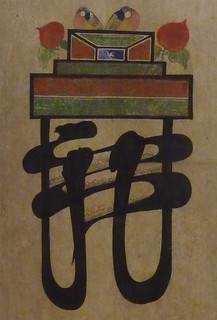Words Without Borders issue on Korean literature.
P’ansori resources
Just doing a little searching for material on p’ansori performance:
- Audio of Scene from Heung Boo-ga, performed by Kim, So-hee, voice; Kim, Yoon-duk, pook
- 100 Icons of Korean Culture episode, “Pansori: A Sound Beyond Sound”
- In fact, there’s a whole P’ansori Channel on YouTube
- This one has a strong storytelling flavor to it
Korea Since 1700: 2013 Book List
 Korea in 1700 was a fairly typical Early Modern East Asian society: educated elites, growing economy and literacy, increasing contacts with other societies; Buddhist and Confucian beliefs, hereditary aristocracies, conservative bureaucratic governance, agricultural tax base. Over the course of the 18th and 19th centuries, the government struggled with factionalism and reform, with an increasingly mercantile economy and with a changing global environment. Though the Korean government rejected Christianity and resisted modern diplomatic ties, late 19th century imperialism forced new ideas and new issues into the forefront. Japan, in particular, involved itself in Korean affairs, first as a trading and reformist presence, then competing with China and Russia for influence in Korea, ultimately forcing Korea into the Japanese empire for decades. After the defeat of Japan in 1945, Korea became a site of tension again, this time between the Cold War superpowers. Those tensions erupted into war, ultimately dividing the Korean people and peninsula into its present political configuration. North Korea has developed a resource-poor Stalinist state headed by a family dynasty; South Korea, after decades of autocratic leadership, has a dynamic participatory democracy and a sophisticated economy and modern culture.
Korea in 1700 was a fairly typical Early Modern East Asian society: educated elites, growing economy and literacy, increasing contacts with other societies; Buddhist and Confucian beliefs, hereditary aristocracies, conservative bureaucratic governance, agricultural tax base. Over the course of the 18th and 19th centuries, the government struggled with factionalism and reform, with an increasingly mercantile economy and with a changing global environment. Though the Korean government rejected Christianity and resisted modern diplomatic ties, late 19th century imperialism forced new ideas and new issues into the forefront. Japan, in particular, involved itself in Korean affairs, first as a trading and reformist presence, then competing with China and Russia for influence in Korea, ultimately forcing Korea into the Japanese empire for decades. After the defeat of Japan in 1945, Korea became a site of tension again, this time between the Cold War superpowers. Those tensions erupted into war, ultimately dividing the Korean people and peninsula into its present political configuration. North Korea has developed a resource-poor Stalinist state headed by a family dynasty; South Korea, after decades of autocratic leadership, has a dynamic participatory democracy and a sophisticated economy and modern culture.
The issues raised by Korea’s history are diverse and challenging, and the role of Korea on the world stage is not likely to diminish anytime soon. Textbook readings and lectures will be heavily supplemented by primary sources — literature, autobiography, Constitutions, oral histories – and secondary scholarship. Class discussion will be central to the course. The writing assignments will allow students to explore their specific interests and the exam will cover the readings and lecture material.
Textbooks
- A History of Korea: An Episodic Narrative, by Kyung Moon Hwang, Palgrave Macmillan, 2010. ISBN 978-0-230-20546-8.
- Korea Old and New: A History, by Eckert, Lee, Lew, Robinson and Wagner. Harvard Korea Institute, 1991. ISBN 0962771309 or 978-0962771309
- Sources of Korean Tradition, Vol. 2: From the Sixteenth to the Twentieth Centuries, edited by Choe, Lee, de Bary. Columbia University Press, 2000. ISBN 0231120311 or 978-0231120319
- Japanese Assimilation Policies in Colonial Korea, 1910-1945, by Mark E. Caprio, University of Washington Press, 2009. ISBN 978-0-295-98901-3
- Bipolar orders: the two Koreas since 1989 By Hyung Gu Lynn. Zed Books, 2007. ISBN 1842777432 or 9781842777435
All of the above books are required reading for the course. They will be available in the PSU Bookstore, but students are welcome to purchase or borrow them from any other source, and in any format. (Though I don’t recommend audiobooks, unless you need them specifically.)
Outside evaluation
Apparently, I’m being a little hard on my students. Do you think so?
For the record, two of you did question 3, two did question 4a and two did question 5.
Final Exam posted
I realized during class that I hadn’t actually posted the final exam online, though I’d given you paper copies. Here it is, just in case you lose your handouts.
North Korea in Pictures
Here’s a Foreign Policy photoessay from 2009 (registration required) by a photographer whose speciality is still-Communist societies after the fall of the Soviet Union and most other Communist states. Here’s his latest, on an unabashedly Maoist town in China.
Reparations and Remains
Japan Focus has a round-up of articles about current issues in Japan-Korea historical reconciliation. I’m particularly interested in the Ahn Jung-geung articles: I understand why he’s considered a hero in Korean history, though I do think there’s some oddity in the current push to raise his profile.
North Korean Pavilion at Shanghai Expo
We now have pictures and a brief description of the soon-to-be-open North Korean pavilion at the World Expo in Shanghai. I don’t think it’s actually going to change many minds about North Korea….
Heir Apparent Appears
Kim Jong Il’s third son, Kim Jong Un, hasn’t been seen in public by the West in a decade or more, but Japan’s Mainichi Shinbun thinks they spotted him. More importantly, he’s starting to take the positions that Kim Jong Il did before he took over from Kim Il Sung. So, maybe.
South Korea’s Suicide Rate
The Washington Post reports on the relatively recent and dramatic rise. It’s worth noting that ‘stress’ is not usually considered a factor in suicide risk assessment, no matter how easy it would be for journalists if it were. Nor does the internet actually increase suicide risk, though the ‘contagion’ factor of famous cases might have some basis in actual science.
